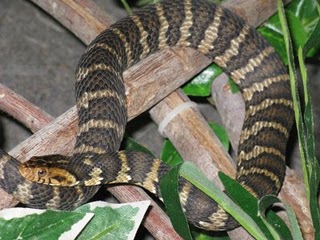 This snake came to us in September of 2008, but its estimated birth date was in August of 2007. The previous owners had it for 6 months and then gave it to a pet store, which then donated the snake to us. We are not sure if the snake is male or female, and I am hesitant to speculate due to the most recent mix up with our black rat snake! However, what I am sure about is that this water snake is unlike most of its kind. Why, you ask? Because it is quite docile and easy to handle!
This snake came to us in September of 2008, but its estimated birth date was in August of 2007. The previous owners had it for 6 months and then gave it to a pet store, which then donated the snake to us. We are not sure if the snake is male or female, and I am hesitant to speculate due to the most recent mix up with our black rat snake! However, what I am sure about is that this water snake is unlike most of its kind. Why, you ask? Because it is quite docile and easy to handle!
If you are a fan of water snakes, you probably already know that they are best left alone. If threatened, they will sometimes stand their ground instead of immediately slithering away. And if intimidation doesn’t work, and you still insist on messing with them, they will not hesitate to strike or bite. However, our banded water snake must have been handled a lot by its previous owners, because it seems very comfortable with being held. This unusual behavior for a water snake makes it a perfect candidate for being an education animal!
But we have a bit of a dilemma when it comes to this non-venomous snake, because we also want to use it as an exhibit animal. The reason why is because water snakes often times get mistaken for the venomous cottonmouth or copperhead snakes, and they are killed unnecessarily (of course, venomous snakes are killed unnecessarily as well, because even they serve a great purpose… but I digress.) So, as much as we would love to use our water snake as an education animal, we also want to put it on exhibit so that people can learn the differences between the banded water snake and the copperhead. For now it is living off-exhibit, but eventually it will be moved on exhibit where it can hopefully be a good educational tool for our visitors.
Banded water snakes are quite common in Eastern North Carolina and can be found in all types of waterways. Their main food sources are small fish and frogs, but they will also eat salamanders and other small creatures that frequent the water. They are often times seen basking on rocks or tree stems that hang over the shallows of the water. We have plenty of water snakes in our wetland here, and on warm days you can usually find at least a couple of them basking at the water’s edge or in low-lying trees. The next time you visit the museum, make sure to look for them in the wetland!
Here is a great video of a closely related species, the northern water snake, taken at Yates Mill in Raleigh by Brad Herring, the same person who puts together all of our munch cams. Speaking of munch cams, look for one in the future of our banded water snake. It’s pretty cool to watch him catch his minnows in the water and then eat them in one big gulp!
My apologies to Kent, who was very unhappy with me for not providing a more natural background with the water snake’s glamour shot for this post.